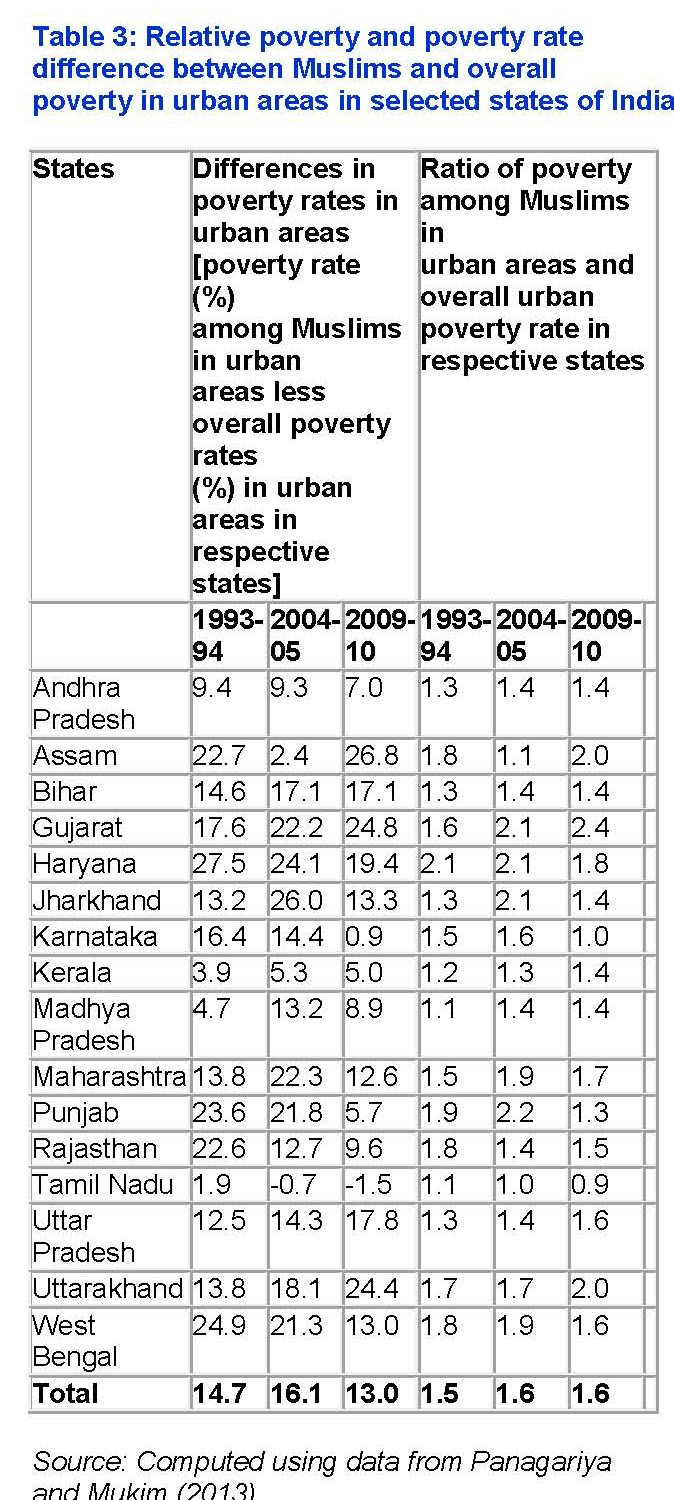|
Minorities at the Margins - continued
Poverty and marginality among Muslims
From Table 3, the following major observations can be made. First, there exists an enormous gap between urban poverty rates among Muslims and overall urban poverty rates in many states. Some of the prominent states which have higher poverty among Muslims than overall poverty are Assam (excess poverty among Muslims in urban areas was +26.8% in 2009-10), Gujarat (+24.8), Uttarakhand (+24.4%), Haryana (+19.4%), Uttar Pradesh (+17.8), Bihar (+17.1%), West Bengal (+13.0), Jharkhand (+13.3%) and Maharashtra (+12.6%). Thus, states with excess urban poverty among Muslims are mainly from the northern and western states.
Second, among states which have shown consistently increasing gaps between poverty rates among Muslims and overall state poverty are Gujarat (+17.6% in 1993-94, +22.2% in 2004-05, and +24.8% in 2009-10), Uttarakhand (+13.8%, +18.1% and +24.4%) and Uttar Pradesh (+12.5%, +14.3% and 17.8%), but in other states, notwithstanding the increase over 1993-94, the gap has either stabilised or declined during 2004-05 and 2009-10. Thus, among the relatively developed states, Gujarat stands out in terms of relative increase in poverty among Muslims in urban areas.
Third, the relative situation of Muslims over the years 1993-94 to 2009-10 has worsened in Gujarat. Muslims in the state have the highest relative poverty (the ratio between poverty rate among Muslims in urban areas in the state and overall urban poverty in the state). Poverty among urban Muslims was 1.6, 2.1 and 2.4 times higher than overall urban poverty in the state, in the years 1993-94, 2004-05 and 2009-10. After Gujarat, the highest relative poverty among Muslims in 1999-10 was in Assam (2.0), Uttarakhand (2.0), Haryana (1.8), and Maharashtra (1.7).
Fourth, at the national level, relative poverty among Muslims is largely stable (1.5 times in 1993-94, 1.6 times each in 2004-05 and 2009-10). This stability is largely due to better performance in southern states like Andhra Pradesh, Karnataka, Tamil Nadu, and also West Bengal where urban poverty among Muslims has declined. In Kerala, relative poverty among Muslims has marginally increased over the years, but this gap in comparison to states like Assam, Gujarat, Haryana, Maharashtra and Uttarakhand is smaller. Thus, we find a major difference between the southern, and northern and western Indian states in terms of dynamics of poverty among Muslims. In fact, it has been the northern and western states of the country which have undergone a significant transformation in social relations due to communal politics, and which have also been centres of communal violence (Shaban 2011). The torn social relations and communalised state machineries and politics act as barriers to developmental programmes and economic and social mobility among Muslims.
Poverty among Muslims in urban areas of Maharashtra
Maharashtra is one of the states that have seen a relative increase in levels of poverty among Muslims in urban areas in 2004-05 and 2009-10, compared to 1993-94 (Table 3). Given that more than 70% of the 10.27 million Muslim population in the state (as per Census 2001; the Census 2011 data on religion-wise distribution of population is still not available) lives in urban areas, this is great cause for concern. An analysis of Census 2011 data shows that a large share of the urban Muslim population lives in Mumbai, Mumbai (Suburban) and Thane district. Other cities like Nagpur, Pune, Nashik and Aurangabad also have a significant number of Muslims. However, among these urban centres, a large share is concentrated in specific towns like Malegaon, Mumbra, Bhiwandi, Mira Road, or marginal, peripheral and poverty-stricken areas of the big cities, like Gowandi, Sonapur-Bhandup, Kurla, Jari Mari, Nagpada, etc, in Mumbai. Detailed data on some of these areas has recently been made available from studies undertaken by the Tata Institute of Social Sciences, Mumbai, and other higher educational institutions in Mumbai.
Marginalisation of Muslims in Malegaon and Mumbra
Malegaon is a typical Muslim town which has, over the years, stagnated due to neglect by development agencies. The town has had a glorious past and for over one-and-a-half centuries has been known for its handloom- and powerloom-based textile industries. The city has often been claimed as the Manchester of the East. However, notwithstanding its glorious history, enterprising peoples and hardworking labourers, this city of about 4.7 lakh population (Census 2011) remains underdeveloped and suffers a number of social problems including communal strife and violence between Hindus and Muslims. Although institutions and networks of mutual help and support among religious communities do exist and are often portrayed as evidence of cooperation and symbiosis, at times they are ruptured and breached to allow inter-religious fights, killings, lootings and mayhem. The city is symbolised by extreme poverty, stark religious segregation, harsh working conditions (often spanning 12-16 hours), lack of housing, sanitation, educational and health facilities, and deafening sound pollution emanating from the looms. In other words, it has not only faced terror activities and communal riots, but also extremely harsh conditions, frightening underdevelopment and stigmatisation.
Continued on next page
|